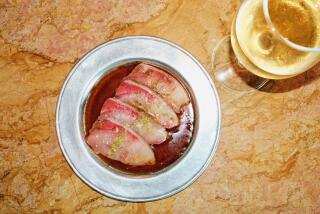Farmers Markets: Oliver Woolley’s pork is a hit in Santa Monica
Locally raised pork is rare in Southern California, but in a hilly grapefruit grove north of San Diego, fenced to exclude mountain lions, 14 tasty piglets luxuriate, fattening for sale at the Santa Monica farmers market. They’re the dream or folly of Oliver Woolley, who raises heritage pigs.
Oliver, 30, was born in Kentucky. He grew up in Colorado and moved with his family in 2003 to a 25-acre farm in Valley Center that grows flowers and organic grapefruit. He studied business at the University of San Diego and worked briefly as a trader for Morgan Stanley but “hated it,” he said. After studying at Le Cordon Bleu in London, he returned home to sell his family’s proteas at farmers markets.
Last year he decided to pursue the family calling in pigs and bestowed on his venture the delightfully arcane name Peads and Barnettsafter his grandparents’ farm near Oxford, England. (Peads is a stream on the property, and barnett is an old English turnip that was originally grown on the farm.)
His grandfather and father commercialized breeding stock of pigs that gained weight quickly and efficiently — his grandfather Ken helped industrialize pork production by co-founding the world’s largest swine genetics firm, the Pig Improvement Company, in England in 1962. But at home they preferred to eat more flavorful older breeds and raised those on their own farms. Following this path, Woolley decided to cross two prized 19th century breeds, Middle White and Mangalitsa.
Paying a couple of thousand dollars each, he bought 18 sows of Middle White, a breed with a distinctive scrunched-up nose that originated in England in the 1850s. It grows quickly, produces dark meat of excellent flavor and is docile enough for farmers to handle easily, so it became popular and was known as “the London porker” in the early 1900s.
He bought two boars of Mangalitsa, which descended from wild boars and were developed in Hungary in the early 19th century. Its name means “hog with a lot of lard,” and this is the feature for which it is most esteemed. With a thick, woolly coat, it is hardy and adaptable but matures slowly.
Woolley combined the best characteristics of these two breeds, raising pigs that mature quickly and produce meat that is very dark compared with typical pork, highly marbled and rich in flavor.
“It’s the best pork I’ve ever worked with,” says Sandy Gendel, the chef and owner of Pace and Sirena.
A family friend maintains the parent pigs at a farm in Colorado. The piglets are shipped to Valley Center at 4 to 5 weeks old, when they’ve just been weaned and weigh 30 to 40 pounds. Woolley feeds his pigs a high-quality antibiotic-free diet of wheat, soy and barley. (Alas, they disdain grapefruit.) When they’re about 250 pounds, at 9 months, he loads a few into a trailer and drives them 320 miles to Creston Valley Meats, a certified slaughterhouse near Paso Robles.
“It’s crazy, but that’s the closest one,” he says.
He started selling pork two weeks ago at the Santa Monica downtown farmers markets on Saturdays and Wednesdays and has been thronged with customers. (He’ll be at a wedding this weekend but returns by Wednesday). Although he charges twice supermarket prices ($13 a pound for chops, $9.50 a pound for shoulder), he still is not sure if pig farming will prove economically viable. Feed costs twice what it would in the Midwest ($630 versus $300 a ton), and the drive to the slaughterhouse is tedious and expensive.
“For now it’s kind of an experiment,” he says. “I’ll continue in a small way until I have a good idea of what it’s going to take to make it work.”
Tips of the week: Windrose Farm, a favorite at the Santa Monica market, just started selling at Hollywood on Sunday. Owner Barbara Spencer has luminously fresh chard, chicory, kale, minutina (a.k.a. erba stella, an Italian heirloom vegetable), stinging nettles and smoked dried tomatoes.
March is prime season for Pixies, the standard of excellence for late-season California mandarins. They’re small, round, light orange and seedless with firm but juicy flesh, an ideal balance of sweetness and acidity, and complex, pleasant aromatics. In most citrus districts around the state, Pixies are mediocre, but this variety reaches perfection in Ojai, where the intense summer heat helps develop sweetness, and cold nights favor rich aromatics and refreshing acidity.
Tony Thacher of Friend’s Ranches, the king of Pixies, sells 3-pound bags for $5 at the Hollywood, Ojai and Santa Monica Wednesday farmers markets. Supermarkets take his larger fruits, which generally is not a problem, since the small ones taste great too; however, his tiniest grade, quarter-sized specimens, which he calls “ponies,” are so small that it’s hard to get a satisfying bite, and they should really be sold separately at a lower price.
The Pixies’ rind adheres tightly but is surprisingly easy to peel. Smaller fruits are easier to eat when sliced longitudinally in quarters.
More to Read
Eat your way across L.A.
Get our weekly Tasting Notes newsletter for reviews, news and more.
You may occasionally receive promotional content from the Los Angeles Times.










